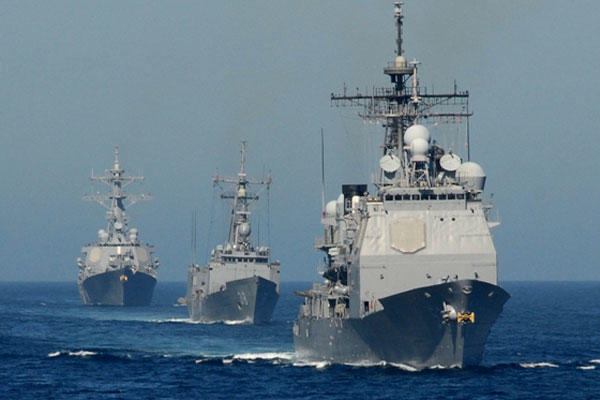The Navy's plan to lay up 11 cruisers and three amphibious ships as part of a cost-saving, long-term modernization plan has been met with skepticism, concern and caution from members of Congress.
The plan involves taking the 14 ships out of their normal deployment rotations and putting them into a maintenance and modernization effort, Navy officials said.
Cutting costs in a restricted budget environment is the main reason for the proposed plan. Laying up nine ships from 2013 through 2017 would save the Navy as much as $6 billion, according to an April Government Accountability Office report.
However, the House Armed Services Committee's mark-up of the fiscal year 2015 budget proposal is putting the brakes on the Navy's plan to lay up the ships and asking them to re-evaluate.
"The committee is concerned about the Navy's plan to reduce its battle force structure by 14 ships, especially in light of shortfalls in the force structure necessary to meet the requirements of the national military strategy," HASC writes.
Members of the committee expressed concern about taking cruisers and amphibs off line at a time when they are needed by the fleet. The Navy's plan would take one half of the service's 22 Ticonderoga-class cruisers out of service.
A HASC amendment requires that the Navy upgrade only two cruisers in 2015. This language was developed to ensure that 11 cruisers were not taken out of the fleet, Congressional sources said. The amendment was proposed and sponsored by Rep. Randy Forbes, R-Va., chairman of the HASC Seapower and Projection Forces Subcommittee.
"The Navy's plan to prematurely remove 11 cruisers from service would significantly degrade the capabilities of the Navy and increases the operations and stress of the remaining force. Keeping these vessels in service, especially while the demand for their missile defense and air warfare capabilities grows, is essential for the health and versatility of our surface Fleet," Forbes told Military.com in a written statement.
The Navy's plan would include 11 Ticonderoga-class cruisers and three amphibious dock landing ships. Saving operational and manning expenses and extending the service life of the cruiser fleet from the 2020s to the 2040s are all parts of the calculus regarding the Navy's rationale, service officials said.
"The Navy's proposal delivers capabilities to ensure our cruiser fleet will continue service through the 2030s and into the 2040s. The last cruiser would decommission in the mid-2040s. Once cruisers are modernized the proposal would replace, on a hull-for-hull basis, the retiring [cruisers] as those ships reach the end of their service life in the 2020s," said Lt. Robert Myers, Navy spokesman.
The laid-up ships are slated to go through what's called hull, mechanical and electrical work before receiving weapons systems and electronics upgrades, Myers explained. The combat systems upgrades consist of work on the ships computers, radar and sonar systems along with the ship's guns and weapons.
The details and timetables regarding exactly which ships will be laid up, and the order in which they will be layed up, is still being determined, Myers added.
"Our proposal to Congress is still being discussed and it is too early to discuss timelines. The Navy's order of when certain cruisers will be modernized will be done in considering ship age, industrial workload, modernization requirements and procurement timelines, as well as material condition," Myers said.
Forbes' amendment plans to pay for upgrades to the two cruisers in 2015 with what's called the Ship Modernization and Sustainment Fund.
In addition, HASC's language asks for a report by March of 2015 detailing the costs, benefits and risks associated with the Navy's phased modernization plan. The committee also asks that the report include information on the costs, savings, benefits and risks of any alternate plans that were considered before the Navy adopted its current plan.
Myers said the Navy plans to work closely with Congress to address their concerns and articulate the merits of the plan.
One analyst said the Navy's plan makes sense given today's tight budget environment where shipbuilding dollars are increasingly scarce.
"This makes enormous sense as long as the nation fails to properly resource the Navy. The Navy is betting that the immediate future of the shipbuilding budget is not going to go up, so they are going to husband the force that they have," said Bryan McGrath, managing director at FerryBridge Group LLC, a defense consulting firm based in Easton, Md.
Having cruisers ready to emerge back into the fleet could prove useful in the future, McGrath added.
"This is a way to maintain an incredibly important force structure at a time of low risk so that it can be available later when there may be greater risk. As the fleet gets smaller and the ship building budget gets crowded out by the construction of the ballistic missile submarine, you will have these ships which you can bring out one at a time," he said.
The Ticonderoga-class of cruisers are engineered for Aegis ballistic missile defense, which uses a mix of computer, missile and radar technology to fire a Standard Missile-3 to knock an approaching enemy projectile out of the sky.
The 567-foot long warships are equipped with Tomahawk missiles, torpedoes, vertical launch tubes for SM-3s and other missiles, SH-60 Sea Hawk helicopters, 5-inch guns and Phalanx close-in-weapons-systems, among other features.
The Navy had planned to build a new class of cruisers called CGX – but that program was cancelled in 2010, paving the way for the upgrades of the existing Ticonderoga-class cruisers, Navy officials said.
-- Kris Osborn can be reached at Kris.Osborn@monster.com.



























